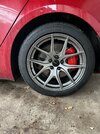Hello!
I have a 2019 M3P. I bought these wheels (in 18x9) and these hub rings, with continental DWS-06+ tires (245/45 R18). I planned on using them as a second set during the colder months in Colorado.
Shortly after mounting, my brakes started to screech. I bought the car used from Tesla, so I assumed the brakes were in good condition. The SC first said they just needed to be burnished, which they did but of course the issue returned. On second visit, I had to get new brakes! I was pretty upset, but got them to knock 50% off of the replacement price since this happened within 2k miles of delivery. They put the wheels back on and the issue hasn’t returned.
But here is what I’m wondering: when I swapped back to the 20” stock wheels for the summer, discount tire didn’t return any hub rings. Could the spacers still be mounted with the stock wheels or were they just not used in the first place, which caused the original issue?
The reason I’m asking is because it’s getting colder and I need to switch out my wheels again, but im afraid to have these wheels mounted again and damage something. Contemplating just putting pilot sport all seasons on, but then that leaves me with these basically new tires and wheels I bought.
Are these wheels compatible when used with hub spacers? Are there downsides to hub spacers and could this have been the cause of my brake damage?
Thanks for any help, I really don’t know much about wheels and fitting them. I’ve tried to read as much as I can but was hoping someone could let me know what they would do in this situation: mount the 18s with hub spacer again or just go all season?
I have a 2019 M3P. I bought these wheels (in 18x9) and these hub rings, with continental DWS-06+ tires (245/45 R18). I planned on using them as a second set during the colder months in Colorado.
Shortly after mounting, my brakes started to screech. I bought the car used from Tesla, so I assumed the brakes were in good condition. The SC first said they just needed to be burnished, which they did but of course the issue returned. On second visit, I had to get new brakes! I was pretty upset, but got them to knock 50% off of the replacement price since this happened within 2k miles of delivery. They put the wheels back on and the issue hasn’t returned.
But here is what I’m wondering: when I swapped back to the 20” stock wheels for the summer, discount tire didn’t return any hub rings. Could the spacers still be mounted with the stock wheels or were they just not used in the first place, which caused the original issue?
The reason I’m asking is because it’s getting colder and I need to switch out my wheels again, but im afraid to have these wheels mounted again and damage something. Contemplating just putting pilot sport all seasons on, but then that leaves me with these basically new tires and wheels I bought.
Are these wheels compatible when used with hub spacers? Are there downsides to hub spacers and could this have been the cause of my brake damage?
Thanks for any help, I really don’t know much about wheels and fitting them. I’ve tried to read as much as I can but was hoping someone could let me know what they would do in this situation: mount the 18s with hub spacer again or just go all season?



